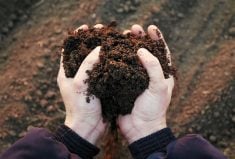How can the world feed itself? That’s the question being asked by the UK’s leading farming publication Farmers Weekly as it launches an international poll in association with Country Guide and a number of other key farming titles around the world.
To take part, just click here. Everyone who enters will get a chance to win a trip for two* to South Africa, kindly supported by Bayer CropScience.
Read Also

China seeks improved ties with Canada amid rising trade tensions
China called on Friday for steps to improve bilateral ties with Canada, saying there were no deep-seated conflicts of interest, following a spike in trade tensions with many of Beijing’s Western trade partners this year.
—————–
How are we going to feed the world? It’s the most important question of the 21st century. It concerns everyone from the wealthiest business tycoons to the wide-eyed hungry of the poorest shanty towns.
As world leaders meet in Copenhagen to discuss a sustainable future for the planet, the timing could not be better for a co-ordinated effort to ask the world’s farmers — the very people who are tasked with providing the solution.
That’s why Farmers Weekly, the UK’s best-selling farming title, is initiating farming’s most wide-reaching poll, in partnership with Country Guide.
Alongside with other leading farming titles around the world, it’s one of the most ambitious online projects the global agricultural community has seen. Almost a million farmers are being asked for their views on solutions to feeding the world.
Taking part is easy: all you need to do is click here. There you’ll find five key factors that will be instrumental in how we nourish a growing population. Just indicate which one you think is the most important. They are:
- Removal of trade barriers
- Government intervention in food production
- Investment in research and development
- Uptake of new technologies and genetic modification
- Broader expertise, through education and training
By voting on the poll you can make your voice heard and you can also see — thanks to a dynamic map — the views of your colleagues around the world.
Farmers Weekly in the UK is also running a forum where you can contribute further to the debate. It’s a unique opportunity to share your views and glean those of a truly worldwide audience. History will be made during this global gathering of agricultural minds — make sure you’re a part of it!
So what are farmers’ views on the big issues? A Dutch dairy farmer would have a very different stance on access to global markets to a wheat grower in Western Australia. Perhaps biofuels and GM offer most to a Midwest corn grower. And where in the world will be the climate change winners? Few are better placed to comment on farmers’ concerns and aspirations than the editors of the world’s leading farming publications.
United States
Being a global food producer is what being a farmer is all about in the U.S.
“It’s as analogous as fourth of July or flying the stars and stripes for a U.S. farmer,” says Dan Looker, business editor of Successful Farming, the nation’s largest-circulation farming publication. “But we’re close to a negative trade balance and the Obama administration is being urged not to ignore trade issues.”
The country is the breadbasket of the world. Its relatively consistent supply of wheat, soybeans and corn largely set the pace of world markets. There are 100 million head of cattle and GM technology is mainstream
But $5 billion per year in direct farm subsidies are proving unpopular to some farmers. These support the commodity producers, largely in the Midwest, and the more entrepreneurial, unsubsidized fruit growers in California, for example, resent the subsidies. “The Senate doesn’t like them, but they survive and additional subsidies have been introduced. Farmers profess to be ambivalent to them, but most commodity groups fight to retain them.”
Meanwhile, initial enthusiasm for biofuels has decidedly waned. “There’s a backlash from various interests against the biodiesel and bioethanol speculative bubble. Questions are now being asked about its carbon footprint – farmers are still very supportive, but the industry is struggling in the public eye.”
The nation’s cattle farmers are under pressure from the Carbon Cap-and-Trade Bill. This sets limits on carbon emissions which will affect the largest livestock producers. “No one is excited about the prospect of a carbon tax. A lot of farmers don’t even believe that global warming exists.”
South Africa
The views of South African farmers are shaped by the varied climate they deal with. This shifts from highly extensive farming in the semi-desert through the maize belt of the Transvaal, to the rich tropical areas of fruit and vines.
“Nowhere in the world do you get so many different climate zones in such a small area, and it gives the farmers a very diverse outlook,” notes Chris Burgess, editor of South Africa Farmers Weekly, the country’s largest farming publication.
Grain production is for the domestic market, or tends to travel no further than near-African neighbours. The country is a net red meat importer. But fruit and wine make South Africa a net exporter of agricultural produce, with the UK its biggest customer. “One of the biggest problems is that farmers compete with highly subsidized imports, so they are very much in favour of removing trade barriers.”
The government has largely shunned biofuels, saying it is not feasible to use food crops for fuel. But the nation’s agriculture is being affected by climate change. “It’s already affecting apple producers. But farmers are more worried about preserving their margins than the long-term effects of climate change.”
Land reform prohibits most the luxury of a long-term view. “It’s a huge issue for South African farmers. Since 1994 vast tracts have come under land claims. Many farmers have found it too much of a challenge and have decided to move elsewhere.”
Australia
Few nations feel more exposed to the threat of climate change than Australia. The debate on global warming and its effect on agriculture preoccupy many of the nation’s farmers.
“There is a degree of skepticism surrounding the science of climate change in many rural communities,” says Ed Gannon, editor of the country’s biggest rural paper The Weekly Times. “But the farming community, which has been in drought for more than a decade, knows it will be the first hit by climate change.”
A net exporter of agricultural commodities, Australia grows its wheat in New South Wales, Victoria and Western Australia. Dairy is concentrated in Victoria and Tasmania, while the big cattle stations are found in northern Australia.
The touchstone issues, beside the climate, are the availability of water, cheap imported food, particularly from China, free trade, increasing government regulation, the rise of the animal welfare lobby and the pressure on farming from urban growth.
“Australian farmers have a more global outlook because they export much of their produce. They are deeply concerned by what they see as unfair trade rules that see cheap food flood into Australia, but prevent access to export markets.”
Opinion on biofuels is split. “There is a debate among farmers that it creates more problems than it solves, in terms of pushing up prices. But there is a push for renewable energy plants in Queensland to take up the sugar glut.”
A polarizing debate surrounds GM. There are limited commercial food crops as governments take a softly-softly approach to the issue.
The Netherlands
Dutch farmers are masters of producing staggering amounts of food from a relatively small area, and are gearing up to supply more to a hungry world.
“Farmers here are very proud of the fact that they produce so much from a small country,” notes Rochus Kingmans, editor of the country’s leading farming publication, Boerderij. “And they can do more — they have mastered a more intensive way of farming because they have a history of doing so.”
Meat and dairy are two areas in particular where the Dutch see opportunities. “When quotas are abolished in 2015, milk production could easily be stepped up by 20-30 per cent. In the pig and poultry sectors there’s talk of mega-farms with up to 300,000 chickens, for example.”
The Netherlands has also learned how to balance this intensive form of farming with the needs of society. Farmers operate under the most stringent environmental regulations in the world, and their units are never too far from non-farming neighbours.
“We’re turning a potential minus into a plus through energy generation from anaerobic digestion, for example — in Holland we believe there is always a technical solution to any problem.”
Biofuels, however, are not part of the solution — “we’ve better uses for land.” But GM is welcomed by the vast majority of producers. “Dutch potato farmers are keen to grow new high-starch varieties. Using the best of technology arable farmers believe a 15-tonne per hectare wheat crop could be commonplace.”
What’s more a move towards more intensive agriculture will help in the battle against climate change, according to Dutch research.
“Studies have shown that large industrialized farms, where all inputs and outputs are monitored closely, score very well on both animal welfare and the environment. Intensification is not necessarily the only solution, but it will be part of it, and Dutch farmers are very well placed to deliver it.”
New Zealand
New Zealand farmers are the most outward-looking in the world. The country has a huge agricultural output that dwarfs the domestic needs of its four million inhabitants. An eye-opening 96 per cent of its dairy output is exported, for example.
“New Zealand is the protein factory to the world, and farmers take a level of comfort in that fact,” claims Tim Fulton, editor of New Zealand Farmers Weekly, the country’s leading farming publication. “Talk over here is dominated by how the industry can capitalize on it.”
The nation’s key strength and envy of the world is its grass-fed production system, supplying lamb and dairy products to European and U.S. markets, among many others. But the national sheep flock has halved over the last 25 years while the dairy herd has risen spectacularly.
“On the South Island in particular dairy has seen big growth with large-scale irrigation and cheap land key drivers. Producers are beginning to look at what housed production systems could offer.”
The nation’s level of agricultural production is not free of internal concern, however. It has been calculated that farming accounts for around 50 per cent of total greenhouse gas emissions and there’s talk of making the industry pay. “Farmers feel unfairly targeted in the climate change debate — dairy in particular has a job defending itself.”
Renewable energy is still seen as a marginal enterprise — perhaps more a route for the country’s state-owned coal exporter to offset its carbon emissions liability, rather than an opportunity for agriculture. Meanwhile, farmers are mostly reserving judgement on GM.
“State-owned trials came under fire for cross-contamination, recently. Farmers see a place for the technology, but there’s no momentum and a small but loud anti-lobby. Besides, our focus is our overseas trade — New Zealand agriculture is a very sustainable system that sells well into key markets the world over. That’s a reputation to build on.”
United Kingdom
The growing demand for food around the world has put UK agricultural production back at the heart of the economy and political thinking.
“For more than a generation, the output of British farmers has almost been taken for granted by consumers and politicians alike,” says Jane King, editor of the UK’s leading farming publication Farmers Weekly.
Now, she says, the scene is changing.
“UK policy is about producing as much food as possible in a sustainable way for the environment.
“We have first-class producers who can rise to the global challenge — we should see ourselves as part of the solution to feeding the planet. We have the products, technology, the practices and the know-how to improve efficiency and increase yield and quality without further damaging the environment.”
In 2008, the UK exported £13 billion worth of food and British farmers see an opportunity to increase their contribution in the future, she points out.
However, there are a number of domestic challenges to overcome — for example strengthening the farm businesses and producers who will be able to offer something on a global scale.
The UK can also make a contribution to feeding the world as a thought leader, and is likely to continue to deliver quality, add value and new thinking, she adds.
A growing number of UK farm businesses are positioning themselves as climate change champions, rather than carbon culprits. Assurance schemes have leant farmers an accountability many are now using to their own advantage.
“There are opportunities the world over to exploit a potential premium market — another prime example of the UK’s pioneering spirit.”
Canada
Given the size of the country you’d expect Canadian growers to be relishing the prospect of raising production to meet rising global demand. But their focus is on value, not volume.
“More than 80 per cent of our wheat production and half of our canola is exported. But much of our wheat-growing area is furthest away in the world from tidewater,” notes John Morriss, editorial director of Country Guide, Canada’s largest national farming magazine. “That makes transport a challenge, so our growers aim for high value markets.”
The climate is also a challenge, especially on the Prairies, with deep, long winters leaving a short, relatively dry growing season. But this also favours the high-quality, high-protein wheat that’s sought after by millers the world over to blend in to improve their grist.
“We have both the honour and curse to share a border with the richest nation in the world,” says Morriss, referring to the sometimes-fickle U.S. market.
Theoretically there is a free trade agreement with the U.S., but the Canadian beef and pork industry — also 50 per cent exported — is currently being “hammered,” partly due to U.S. trade restrictions, he says. The rise of biofuels, although favoured by arable farmers, is further squeezing the livestock sector, which is finding it hard to source cheap feed grains. “The pig sector’s in meltdown.”
Nearly all canola is GM, but there’s strong resistance to the prospect of GM wheat. “Canadian growers like the ease of GM canola and the market’s not fussed. But people have a different view on wheat. Growers are worried they could lose access to lucrative markets and there could be weed problems if there were two Roundup Ready crops in the rotation.”
And just as climate strictly shapes what Canadian farmers grow, they feel vulnerable to the effects of climate change. “In the past we have seen prolonged droughts in the semiarid West — our main wheat-growing area. A longer growing season could help yields but if that also meant less rainfall, yields could suffer.”
— Tom Allen-Stevens is a contributing writer to Farmers Weekly and operates Wicklesham Farm near Faringdon in Oxfordshire, England.
————–
* — Including two tickets to one World Cup finals football match. Terms and conditions of prize draw:
- Entry is only open to individuals of 18 years or older and who reside in the UK, United States of America, Australia, South Africa, New Zealand, Canada, Netherlands or Republic of Ireland.
- Entries from persons residing in any other part of the world will not be entered into the draw.
- The prize is for economy class return flights for two to South Africa from the prize winner’s country of residence plus five night’s accommodation in a hotel chosen by the prize provider and two tickets to one football World Cup finals match. Transfers are not included.
- No guarantee can be made concerning which football match is offered.
- The winner must be available to travel between Wednesday, June 9 and Wednesday July 14, 2010, and agree to the itinerary on offer.
- The winner will be contacted by email.














